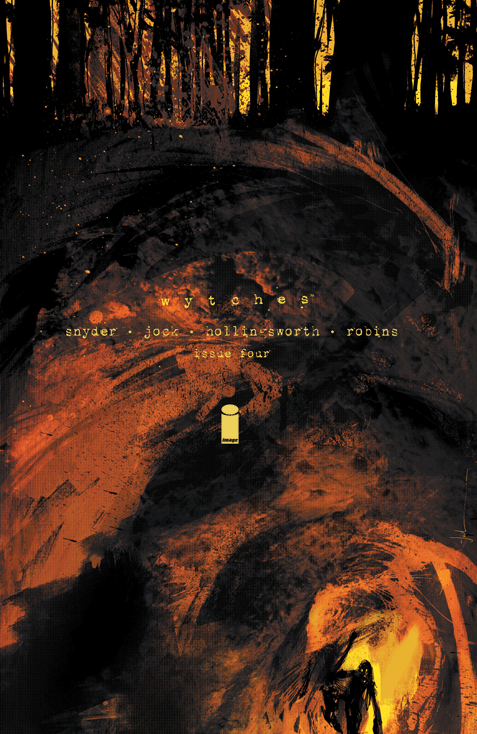Scott Snyder and Jock's "Wytches" keeps its crown as one of the creepiest titles on the shelves. Issue #4 opens up the mythology of its antagonists and the history of its protagonists, providing explanations and intrigue just as the novelty of the setting and premise wind down. Snyder digs in and exposes the guilty, anxious heart of the story, while Jock and Matt Hollingsworth keep the atmosphere as tense and strange as ever. "Wytches" #4 does what it needs to keep the reader hooked.
Matt Hollingsworth's colors are easily the book's most distinctive and contentious feature. The invasive, splattering finish that covers everything makes events indistinct and objects misshapen; it's difficult to see precisely what's going on, and the setting blurs out of recognizable, concrete spaces. As a result, even the most clearly planted clues and reveals feel less sure, and the "A-ha" moments read more like "I think that's what I saw?" moments. This effect mirrors the protagonists' disorientation in the woods, and even visually mimics the dappling of light through leaves, so I can see why Hollingsworth chose it. When the characters are scrabbling or running, the coloring amplifies everything brilliantly. However, less is undeniably more with this effect, and Hollingsworth is occasionally a bit heavy in this issue. Going forward, I hope that he can show restraint when he needs to -- even the most immersive horror comic needs a few genuine "A-ha" scenes.
Snyder also obscures plenty in this issue. The past intertwines with the present, the heroes aren't exactly heroic and Sailor -- who I thought was the protagonist -- doesn't get a great deal of point-of-view storytelling. Charlie's worry for Sailor in the present plays queasily with his despicable behavior from the past, and it's all a sinking testament to the horror of parenthood: just because you love your child doesn't mean you aren't helplessly, irreparably toxic for them. Sailor's strength in the face of that is both comforting and devastating: Charlie's daughter can survive him, but that also means she had to.
Jock handles all the colliding story elements -- past, present, multiple locations -- with finesse and fine pacing. The climax of the Ferris wheel flashback, mixed with the arrival of the wytches, is near perfectly framed and paced. It really made the flashback land. Oddly enough, the more traditional parts of the story are where Jock falters slightly. I couldn't always understand the prioritizing during Charlie's discussion on the Here Coast, and some of the physicality -- the brandishing of knives, the pricking of fingers -- didn't read quite right. Admittedly, Jock's work was also occasionally overwhelmed by Hollingsworth's coloring, so that may have affected my read, but there were a few areas that felt rushed this issue. Still, I love the variety of lines in Jock's work, from fat, almost painterly brushstrokes to pencil-thin details on the characters' faces. He's surprised me in every issue, and I'm sure he'll do it again in issue #5.
From the "chit-chit-chit" noises to the subtext, "Wytches" is a skin-crawling achievement. You should definitely read it -- just not at night.

